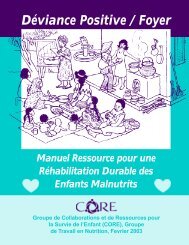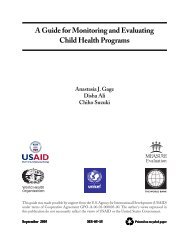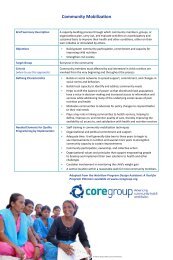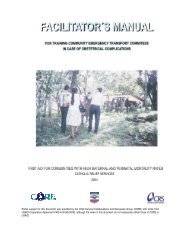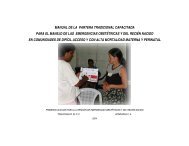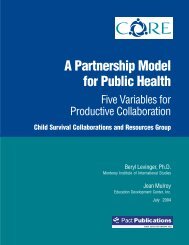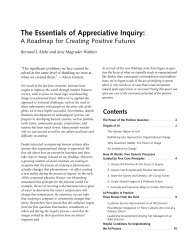Improving Adherence to Treatment - CORE Group
Improving Adherence to Treatment - CORE Group
Improving Adherence to Treatment - CORE Group
Create successful ePaper yourself
Turn your PDF publications into a flip-book with our unique Google optimized e-Paper software.
<strong>Improving</strong> <strong>Adherence</strong> <strong>to</strong> <strong>Treatment</strong>Ira B. Wilson, MD, MScProfessor of Community HealthBrown UniversityProvidence, RI
Goals• Background• Principles• Practice
What’s the Problem?• Problem: Medication nonadherence is endemic• Consequences– Poor health outcomes– 30%–60% of hospitalizations may be adherencerelated– Costs: $177B 1 <strong>to</strong> $290B 2 in the United States annually• Total US healthcare costs $2.24 trillion 3– Very large amounts of hidden time, energy, hassle forproviders1. Ernst and Grizzle. J Am Pharm Assoc. 2001;41:192-129.2. New England Healthcare Institute. Thinking Outside the Pillbox: A System-wide Approach <strong>to</strong> <strong>Improving</strong>Patient Medication <strong>Adherence</strong> for Chronic Disease. A NEHI Research Brief, July 2009.3. Hartman et al. Health Affairs. 2010;29;147-155.
Epidemiology• Original Sackett and Haynes data: thefamous 50%• Better drugs don’t solve the problemSackett and Haynes, eds. Compliance with Therapeutic Regimens. Baltimore, MD: Johns Hopkins UniversityPress; 1976.
Cholesterol: StatinsAdapted with permission from Benner et al. JAMA. 2002;288:455-461.
CancerAdapted with permission from Cuzick and Edwards. Lancet.1999;353:930.
Longitudinal <strong>Adherence</strong> in HIVWilson IB for the MACH14 Investiga<strong>to</strong>rs. 5 th International Conference on HIV <strong>Treatment</strong> <strong>Adherence</strong>, Miami, FLA, May23-25, 2010.
How Good Are Doc<strong>to</strong>rs at:• Diagnosing nonadherence• Treating nonadherence
Diagnosing Nonadherence• Caron HS, Roth HP. Patients’ cooperation with a medical regimen. Difficulties in identifying thenoncoopera<strong>to</strong>r. JAMA. 1968;203:922-926.• Hall JA, Stein TS, Roter DL, Rieser N. Inaccuracies in physicians' perceptions of their patients. Med Care.1999;37:1164-1168.• Roth HP, Caron HS. Accuracy of doc<strong>to</strong>rs’ estimates and patients’ statements on adherence <strong>to</strong> a drugregimen. Clin Pharmacol Ther. 1978;23:361-370.• Mushlin AI, Appel FA. Diagnosing potential noncompliance. Physicians’ ability in a behavioral dimension ofmedical care. Arch Intern Med. 1977;137:318-321.• Blowey DL, Hebert D, Arbus GS, et al. Compliance with cyclosporine in adolescent renal transplant recipients.Pediatr Nephrol. 1997;11:547-551.• Gilbert JR, Evans CE, Haynes RB, Tugwell P. Predicting compliance with a regimen of digoxin therapy infamily practice. Can Med Assoc J. 1980;19;123:119-122.• Charney E, Bynum R, Eldredge D, et al. How well do patients take oral penicillin? A collaborative study inprivate practice. Pediatrics. 1967;40:188-195.• Bosley CM, Fosbury JA, Cochrane GM. The psychological fac<strong>to</strong>rs associated with poor compliance withtreatment in asthma. Eur Respir J. 1995;8:899-904.• Steiner JF. Provider assessments of compliance with zidovudine. Arch Intern Med. 1995;155:335-336.• Gross R, Bilker WB, Friedman HM, et al. Provider inaccuracy in assessing adherence and outcomes withnewly initiated antiretroviral therapy. AIDS. 2002;16:1835-1837.• Bangsberg DR, Hecht FM, Clague H, et al. Provider assessment of adherence <strong>to</strong> HIV antiretroviral therapy. JAcquir Immune Defic Syndr. 2001;26:435-442.• Paterson DL, Swindells S, Mohr J, et al. <strong>Adherence</strong> <strong>to</strong> protease inhibi<strong>to</strong>r therapy and outcomes in patientswith HIV infection. Ann Intern Med. 2000;133:21-30.• Haubrich RH, Little SJ, Currier JS, et al. The value of patient-reported adherence <strong>to</strong> antiretroviral therapy inpredicting virologic and immunologic response. AIDS. 1999;13:1099-1107.
<strong>Adherence</strong> Interventions• Long-term treatments– 36 of 81 interventions in 69 RCTs were associated withimprovements in adherence, but only 25 wereassociated with improvements in outcome– Almost all the effective interventions were complex– Even the most effective interventions did not lead <strong>to</strong>large improvements in adherence or treatmen<strong>to</strong>utcomes– “Current methods for improving adherence for chronichealth outcomes are mostly complex and not veryeffective.”Haynes et al. Cochrane Database Syst Rev. 2008 Apr 16;(4):CD000011.
<strong>Adherence</strong> Interventions in HIV• Most recent meta analysis– 48 studies, 4810 participants– Odds of achieving 95% adherence inintervention compared with control arm 1.66(1.54-1.78)Amico KR, et al. 4th International Conference on HIV <strong>Treatment</strong> <strong>Adherence</strong>. Miami, FL; April 2009.
<strong>Adherence</strong> Interventions in HIV• “Published reports of behavioralinterventions both recently and in the pastdecade suggest it is possible <strong>to</strong> intervenein ways that promote antiretroviralmedication adherence, but effects aregenerally small and transi<strong>to</strong>ry and thereare no clearly demonstrated simplestrategies.”Simoni JM et al. Curr HIV/AIDS Rep. 2010 Feb;7(1):44-51.
Principles• Patient-centered care• Adult learning theory• Motivational interviewing
Patient-Centered CarePatient-centered — “providingcare that is respectful of andresponsive <strong>to</strong> individualpatient preferences, needs,and values, and ensuring thatpatient values guide allclinical decisions.”Institute of Medicine, Crossing the QualityChasm, 2001Reprinted with permission from Committee on Quality of Health Care in America, Institute of Medicine. Crossing theQuality Chasm: A New Health System for the 21st Century Committee on Quality of Health Care in America.Washing<strong>to</strong>n, DC: Institute of Medicine National Academy Press; 2001.
• Pedagogy vs. Andragogy• PedagogyHow Do Adults Learn?– “paid” = child– “agagos” = leader of• Principles of pedagogy– Teacher decides what is <strong>to</strong> be learned, how<strong>to</strong> learn it, when <strong>to</strong> learn it, and if it has beenlearned– Teacher directed; learner generally passive,follows directions
Andragogy (Malcolm Knowles)• Translation: Man-leading• Learners learn when they “need <strong>to</strong> know”’ when theinformation is important in their life• Self-concept of the learner– Au<strong>to</strong>nomous: responsible for their own decisions– Self-directing: dependent vs. self-directing learners– Resent and resist others telling them what <strong>to</strong> learn• Prior experience of the learner– Resources and experience– Mental models– To ignore is <strong>to</strong> devalue the learner and their experience
Motivational Interviewing• Motivational interviewing is a clientcentered,directive method for enhancingintrinsic motivation <strong>to</strong> change by exploringand resolving ambivalence• Non-judgmental, non-confrontational, andnonadversarial
Summary of Principles• Patient-centered care as a characteristic ofquality is here <strong>to</strong> stay– This has implications for medication adherenceas a behavior• It may be useful <strong>to</strong> base approaches <strong>to</strong>improving medication adherence on:– Well-established principles about how adultslearn– Proven behavioral change methods andtechniques
Practice• <strong>Improving</strong> medication adherence is a skill– Diagnosis– <strong>Treatment</strong>
Making the Diagnosis• Wrong diagnosis, wrong treatment• Diagnosing nonadherence is difficult– If they are nonadherent– Why they are nonadherent• Voluntary vs. involuntary nonadherence
Voluntary Nonadherence• Not convinced it is really needed• Doesn’t think it is working• Having a side effect or possible side effect• Stigmatized by the diagnosis• Stigmatized by medication taking• Bad press for other medicines: rofecoxib androsiglitazone• Thinks they are on <strong>to</strong>o many medicines• Just doesn’t like taking medications• Confused
Involuntary Nonadherence• Forgetting doses• Forgetting <strong>to</strong> get refills• Irregular schedule• Working, childcare, etc• Problems with personal organization• Cost problems
The Hard Part• One size does not fit all– Patients think about each medicationdifferently (see Elliott et al)• There are often multiple reasons whypatients don’t take their medications theway you would like them <strong>to</strong>Elliott et al. J Gen Intern Med. 2007;22:805-810.
Making the Diagnosis• Get the data (do a good his<strong>to</strong>ry)– You can only get an accurate his<strong>to</strong>ry by listening– Patients will only tell you the truth if they want <strong>to</strong>– Patients will NOT want <strong>to</strong> if you use it against them• What works: listen, learn, explore; understandwhat their experiences have been (Pound et al)– Causal models– Attributions– “People almost never change without first feelingunders<strong>to</strong>od.” (S<strong>to</strong>ne et al.)Pound et al. Soc Sci Med. 2005;61:133-155. S<strong>to</strong>ne D, Pat<strong>to</strong>n B, Heen S. Difficult Conversations, 1999
Useful Questions• How do you think these medications areworking?• What is it like taking all thesemedications?• Do you think you are on <strong>to</strong>o manymedications?• What’s the worst part for you about takingall these medications?
Useful Questions• What worries you the most?• What do you think is going on?• What is your theory?• How do you put this all <strong>to</strong>gether?• What questions do you have for me aboutyour medications? (NOT: Do you haveany questions?)• What else?
Summary Points: Diagnosis• Intentional and non-intentionalnonadherence• <strong>Adherence</strong> problems can be multifac<strong>to</strong>rial• Accurate diagnosis is a precondition foreffective treatment . . . so you have <strong>to</strong> geta good his<strong>to</strong>ry
<strong>Treatment</strong>• Listen well• Understand ambivalence• Avoid direct persuasion• Inform skillfully• Be clear and direct
Listen Well• Medical model: Patients come <strong>to</strong> you foranswers and expertise• Behavior change model: Answers lie within thepatient, and finding those answers requireslistening• “A practitioner who is listening, even if it is justfor a minute, has no other immediate agendathan <strong>to</strong> understand the other persons’perspective and experience.”Rollnick et al. Motivational Interviewing In Health Care: Helping Patients Change Behavior. New York:Guilford Press, 2008.
Reflective Listening• Repeat back <strong>to</strong> the patient what you justheard, using different words that guess atmeaning
Reflective ListeningD: How do you think your medications are working?P: OK.D: But not great.P: Well, I don’t know.D: You’re worried about one of them.P: I guess . . . the lipi<strong>to</strong>r.D: Your concerned it’s not working.P: No, I know that it is working but I worry about diabetes.D: Tell me more about that.P: Well, I read that statins can cause diabetes.D: And you are concerned that you might get diabetes if youkeep taking the lipi<strong>to</strong>rP: Right. What’s the s<strong>to</strong>ry there?
PROs and CONs of Taking ARVs• PROs– Keep me fromgetting sick• CONs– I feel fine right now– Don’t like <strong>to</strong> bereminded I have HIV– Potential side effects– People may figureout I’m positive atwork– Don’t like taking pills– “I heard in my churchthat they can hurtyou.”ARV = antiretroviral.
Understand Ambivalence• People are often ambivalent about takingmedications• There are PROs and CONs <strong>to</strong> taking anymedicine, particularly ARVs• PROs favor change, CONs favor stayingthe same• Goal of motivational interviewing is <strong>to</strong>produce change talk, <strong>to</strong> make the PROsoutweigh the CONs
Avoid Direct Persuasion• Doc<strong>to</strong>r-centered information delivery• Finger shaking or threatening• Lecturing, convincing, or cheerleading
What <strong>to</strong> Do• Listen reflectively• Listen for change talk and guide them <strong>to</strong>expand on that
Change Talk• Desire: Statements about preference forchange– “I want <strong>to</strong> . . .”– “I would like <strong>to</strong> . . .”– “I wish . . .”• Ability: Statements about capability– “I could . . .”– “I would . . .”– “I might be able <strong>to</strong> . . .”
Change Talk• Reasons: Specific arguments aboutchange– “I probably would feel better if I . . .”– “I need <strong>to</strong> have more energy <strong>to</strong> play with mykids.”• Need: Statements about feeling obliged <strong>to</strong>change– “I ought <strong>to</strong> . . .”– “I have <strong>to</strong> . . .”– “I really should . . .”
Change Talk• Commitment: Statements about thelikelihood of change– “I am going <strong>to</strong> . . .”– “I will . . .”– “I intend <strong>to</strong> . . .”• Taking steps: Statement about actiontaken– “I actually went out and . . .”– “This week I started . . .”
Inform Skillfully• Ask permission• Offer choices• Talk about what others do• Simplify the message
Inform Skillfully• Ask permission– “Would you like <strong>to</strong> know some things otherpatients have done?”– “Would it be all right if I tell you one concern Ihave about this plan?”– “May I make a suggestion?”– “I have a couple of thoughts about what youjust said, may I share them with you?”
Inform Skillfully• Offer choices– “One approach would be <strong>to</strong> continue themedications that you were taking, anotherapproach would be <strong>to</strong> try <strong>to</strong> find a regimen whereyou only had <strong>to</strong> take pills once a day. What areyour thoughts?”– “One approach would be for you <strong>to</strong> concentrateon reducing your salt intake and losing weight,and if your blood pressure wasn’t better in 8weeks, we could add another medication.Another approach would be <strong>to</strong> add the othermedication <strong>to</strong>day. Which approach makes moresense <strong>to</strong> you?”
Inform Skillfully• Talk about what others do– “Some patients want <strong>to</strong> wait until they are clean<strong>to</strong> start taking ARVs, but others think it isimportant <strong>to</strong> start ARVs right away, and work onthe drug problem at the same time or later. Whatdo you think would work best for you?”• Simplify the message– Chunk – check – chunk– Elicit – provide – elicit• Ask what they want <strong>to</strong> know• Provide the requested information• Ask if they unders<strong>to</strong>od
Be Clear and Direct• Confusion about physicians’ expectations iscommon– What the regimen is– How important it is <strong>to</strong> follow it rigorously• Ask permission, but then make advice aboutadherence clear and direct• Guide patients with information, clear advice,and support



